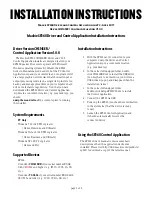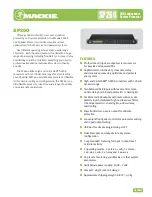
The following rules must be followed with geographically dispersed clusters:
•
A network connection with latency of 500 milliseconds or less ensures that cluster consistency
can be maintained. If the network latency is over 500 milliseconds, the cluster consistency
cannot be easily maintained.
•
All nodes must be on the same subnet.
Cluster groups and resources, including file shares
The Failover Cluster Management tool provides complete online help for all cluster administration
activities.
Cluster resources include administrative types of resources as well as file shares. The following
paragraphs include overview and planning issues for cluster groups, cluster resources, and clustered
file shares.
Creating and managing these resources and groups must be managed through Failover Cluster
Management.
Cluster group overview
A default cluster group is automatically created when the cluster is first created. This default cluster
group contains an Internet Protocol (IP) Address resource, a Network Name resource, and the
Quorum disk resource. When the new cluster is created, the (IP) address and the cluster name that
were specified during setup are set up as the IP address and network name of this default cluster
group.
CAUTION:
Do not delete or rename the Cluster Group or IP Address. Doing so results in losing
the cluster and requires reinstallation of the cluster.
When creating groups, the administrator's first priority is to gain an understanding of how to
manage the groups and their resources. Administrators may choose to create a resource group
and a virtual server for each node that will contain all resources owned by that node, or the
administrator may choose to create a resource group and virtual server for each physical disk
resource. Additionally, the administrator should try to balance the load of the groups and their
resources on the cluster between the nodes.
Node-based cluster groups
Creating only one resource group and one virtual server for each node facilitates group and
resource administration. This setup allows administrators to include all file share resources under
one group. Clients access all of the resources owned by one node through a virtual server name.
In node-based cluster groups, each group has its own network name and IP address. The
administrator decides on which node to place each physical disk resource. This configuration
provides a very coarse level of granularity. All resources within a group must remain on the same
node. Only two IP addresses and network names are required. This configuration creates less
overhead for resource and network administration. A possible disadvantage of this approach is
that the resource groups can potentially grow large when many file shares are created.
Load balancing
The creation of separate cluster groups for each virtual server provides more flexibility in balancing
the processing load on the cluster between the two nodes. Each cluster group can be assigned to
a cluster node with the preferred owner parameter. For example, if there are two cluster groups,
the cluster could be set up to have the first cluster group owned by Node A and the second cluster
group owned by Node B. This allows the network load to be handled by both devices
simultaneously. If only one cluster group exists, it can only be owned by one node and the other
node would not serve any network traffic.
68
Cluster administration
















































